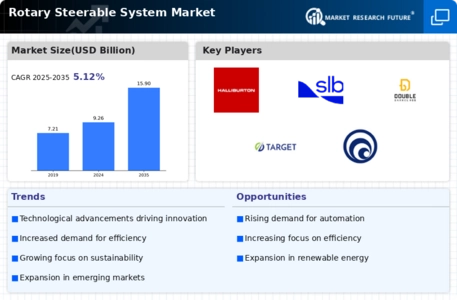-
EXECUTIVE SUMMARY
-
MARKET ATTRACTIVENESS ANALYSIS
- GLOBAL ROTARY STEERABLE SYSTEM MARKET, BY TYPE
- GLOBAL ROTARY STEERABLE SYSTEM MARKET, BY APPLICATION
- GLOBAL ROTARY STEERABLE SYSTEM MARKET, BY REGION
-
MARKET INTRODUCTION
-
DEFINITION
-
SCOPE OF THE STUDY
-
MARKET STRUCTURE
-
RESEARCH METHODOLOGY
-
RESEARCH PROCESS
-
PRIMARY RESEARCH
-
SECONDARY RESEARCH
-
MARKET SIZE ESTIMATION
-
TOP-DOWN AND BOTTOM-UP APPROACH
-
FORECAST MODEL
-
LIST OF ASSUMPTIONS & LIMITATIONS
-
MARKET DYNAMICS
-
INTRODUCTION
-
DRIVERS
- GROWING SHALE OIL AND GAS INDUSTRY
- INCREASE IN INVESTMENTS TOWARD DIRECTIONAL DRILLING
- DRIVERS IMPACT ANALYSIS
-
RESTRAINTS
- ENVIRONMENTAL CONCERNS ASSOCIATED WITH THE HYDRAULIC FRACTURING PROCESS
- RESTRAINTS IMPACT ANALYSIS
-
OPPORTUNITIES
- NEW OILFIELD DISCOVERIES
-
IMPACT ANALYSIS OF COVID-19
- IMPACT ON OIL & GAS INDUSTRY
- IMPACT ON ROTARY STEERABLE SYSTEM MARKET
- IMPACT ON SUPPLY CHAIN OF ROTARY STEERABLE SYSTEM MARKET
- IMPACT ON THE MARKET DEMAND FOR ROTARY STEERABLE SYSTEM
- IMPACT ON PRICING OF ROTARY STEERABLE SYSTEM
-
MARKET FACTOR ANALYSIS
-
SUPPLY CHAIN ANALYSIS
- RAW MATERIALS SUPPLIERS
- ROTARY STEERABLE SYSTEM MANUFACTURERS
- DISTRIBUTION CHANNELS
- END-USERS
-
PORTER''S FIVE FORCES MODEL
- THREAT OF NEW ENTRANTS
- BARGAINING POWER OF SUPPLIERS
- THREAT OF SUBSTITUTES
- BARGAINING POWER OF BUYERS
- INTENSITY OF RIVALRY
-
GLOBAL ROTARY STEERABLE SYSTEM MARKET, BY TYPE
-
OVERVIEW
- GLOBAL ROTARY STEERABLE SYSTEM MARKET ESTIMATES & FORECAST BY TYPE, 2024-2032
-
PUSH THE BIT
- PUSH THE BIT MARKET ESTIMATES & FORECAST BY REGION,2024-2032
-
POINT THE BIT
- POINT THE BIT MARKET ESTIMATES & FORECAST BY REGION,2024-2032
-
OTHERS
- OTHERS MARKET ESTIMATES & FORECAST BY REGION,2024-2032
-
GLOBAL ROTARY STEERABLE SYSTEM MARKET, BY APPLICATION
-
OVERVIEW
- GLOBAL ROTARY STEERABLE SYSTEM MARKET ESTIMATES & FORECAST BY APPLICATION, 2024-2032
-
ONSHORE
- ONSHORE: MARKET ESTIMATES & FORECAST BY REGION,2024-2032
-
OFFSHORE
- OFFSHORE MARKET ESTIMATES & FORECAST BY REGION,2024-2032
-
GLOBAL ROTARY STEERABLE SYSTEM MARKET, BY REGION
-
OVERVIEW
-
NORTH AMERICA
- US
- CANADA
- MEXICO
-
EUROPE
- UK
- RUSSIA
- GERMANY
- NORWAY
- FRANCE
- ITALY
- REST OF EUROPE
-
ASIA-PACIFIC
- CHINA
- JAPAN
- INDIA
- SOUTH KOREA
- REST OF ASIA-PACIFIC
-
LATIN AMERICA
- BRAZIL
- ARGENTINA
- REST OF LATIN AMERICA
-
MIDDLE EAST & AFRICA
- SAUDI ARABIA
- UAE
- SOUTH AFRICA
- REST OF MIDDLE EAST & AFRICA
-
COMPETITIVE LANDSCAPE
-
INTRODUCTION
-
COMPETITIVE BENCHMARKING
-
KEY DEVELOPMENT ANALYSIS
-
KEY DEVELOPMENTS & GROWTH STRATEGIES
- PRODUCT LAUNCHES/PRODUCT APPROVALS
- COLLABORATIONS
-
COMPANY PROFILES
-
BAKER HUGHES, A GE COMPANY LLC
- COMPANY OVERVIEW
- FINANCIAL OVERVIEW
- PRODUCTS/SERVICES OFFERED
- KEY DEVELOPMENTS
- SWOT ANALYSIS
- KEY STRATEGIES
-
HALLIBURTON
- COMPANY OVERVIEW
- FINANCIAL OVERVIEW
- PRODUCTS OFFERED
- KEY DEVELOPMENTS
- SWOT ANALYSIS
- KEY STRATEGIES
-
NATIONAL OILWELL VARCO, INC.
- COMPANY OVERVIEW
- FINANCIAL OVERVIEW
- PRODUCTS OFFERED
- KEY DEVELOPMENTS
- SWOT ANALYSIS
- KEY STRATEGIES
-
APS TECHNOLOGY, INC.
- COMPANY OVERVIEW
- FINANCIAL OVERVIEW
- PRODUCTS OFFERED
- KEY DEVELOPMENTS
- SWOT ANALYSIS
- KEY STRATEGIES
-
DOUBLE BARREL RSS
- COMPANY OVERVIEW
- FINANCIAL OVERVIEW
- PRODUCTS OFFERED
- KEY DEVELOPMENTS
- SWOT ANALYSIS
- KEY STRATEGIES
-
NABORS INDUSTRIES LTD.
- COMPANY OVERVIEW
- FINANCIAL OVERVIEW
- PRODUCTS OFFERED
- KEY DEVELOPMENTS
- SWOT ANALYSIS
- KEY STRATEGIES
-
GYRODATA INCORPORATED
- COMPANY OVERVIEW
- FINANCIAL OVERVIEW
- PRODUCTS OFFERED
- KEY DEVELOPMENTS
- SWOT ANALYSIS
- KEY STRATEGIES
-
SCHLUMBERGER LIMITED
- COMPANY OVERVIEW
- FINANCIAL OVERVIEW
- PRODUCTS/SERVICES OFFERED
- KEY DEVELOPMENTS
- SWOT ANALYSIS
- KEY STRATEGIES
-
WEATHERFORD INTERNATIONAL PLC
- COMPANY OVERVIEW
- FINANCIAL OVERVIEW
- PRODUCTS/SERVICES OFFERED
- KEY DEVELOPMENTS
- SWOT ANALYSIS
- KEY STRATEGIES
-
EAM DRILLING SYSTEMS, LLC
- COMPANY OVERVIEW
- FINANCIAL OVERVIEW
- PRODUCTS/SERVICES OFFERED
- KEY DEVELOPMENTS
- SWOT ANALYSIS
- KEY STRATEGIES
-
TARGET ENERGY SOLUTIONS
- COMPANY OVERVIEW
- FINANCIAL OVERVIEW
- PRODUCTS/SERVICES OFFERED
- KEY DEVELOPMENTS
- SWOT ANALYSIS
- KEY STRATEGIES
-
HUISMAN EQUIPMENT B.V.
- COMPANY OVERVIEW
- FINANCIAL OVERVIEW
- PRODUCTS/SERVICES OFFERED
- KEY DEVELOPMENTS
- SWOT ANALYSIS
- KEY STRATEGIES
-
D-TECH ROTARY STEERABLE
- COMPANY OVERVIEW
- FINANCIAL OVERVIEW
- PRODUCTS/SERVICES OFFERED
- KEY DEVELOPMENTS
- SWOT ANALYSIS
- KEY STRATEGIES
-
APPENDIX
-
REFERENCES
-
RELATED REPORTS
-
-
LIST OF TABLES
-
LIST OF ASSUMPTIONS & LIMITATIONS
-
GLOBAL ROTARY STEERABLE SYSTEM MARKET ESTIMATES & FORECAST, BY TYPE, 2024-2032 (USD MILLION)
-
PUSH THE BIT MARKET ESTIMATES & FORECAST, BY REGION, 2024-2032 (USD MILLION)
-
POINT THE BIT MARKET ESTIMATES & FORECAST, BY REGION, 2024-2032 (USD MILLION)
-
OTHERS MARKET ESTIMATES & FORECAST, BY REGION, 2024-2032 (USD MILLION)
-
GLOBAL ROTARY STEERABLE SYSTEM MARKET ESTIMATES & FORECAST, BY APPLICATION, 2024-2032 (USD MILLION)
-
ONSHORE MARKET ESTIMATES & FORECAST, BY REGION, 2024-2032 (USD MILLION)
-
OFFSHORE MARKET ESTIMATES & FORECAST, BY REGION, 2024-2032 (USD MILLION)
-
GLOBAL ROTARY STEERABLE SYSTEM MARKET, BY REGION, 2024-2032 (USD MILLION)
-
NORTH AMERICA: ROTARY STEERABLE SYSTEM MARKET, BY COUNTRY, 2024-2032 (USD MILLION)
-
NORTH AMERICA: ROTARY STEERABLE SYSTEM MARKET, BY TYPE, 2024-2032 (USD MILLION)
-
NORTH AMERICA: ROTARY STEERABLE SYSTEM MARKET, BY APPLICATION, 2024-2032 (USD MILLION)
-
US: ROTARY STEERABLE SYSTEM MARKET, BY TYPE, 2024-2032 (USD MILLION)
-
US: ROTARY STEERABLE SYSTEM MARKET, BY APPLICATION, 2024-2032 (USD MILLION)
-
CANADA: ROTARY STEERABLE SYSTEM MARKET, BY TYPE, 2024-2032 (USD MILLION)
-
CANADA: ROTARY STEERABLE SYSTEM MARKET, BY APPLICATION, 2024-2032 (USD MILLION)
-
MEXICO: ROTARY STEERABLE SYSTEM MARKET, BY TYPE, 2024-2032 (USD MILLION)
-
MEXICO: ROTARY STEERABLE SYSTEM MARKET, BY APPLICATION, 2024-2032 (USD MILLION)
-
EUROPE: ROTARY STEERABLE SYSTEM MARKET, BY COUNTRY, 2024-2032 (USD MILLION)
-
EUROPE: ROTARY STEERABLE SYSTEM MARKET, BY TYPE, 2024-2032 (USD MILLION)
-
EUROPE: ROTARY STEERABLE SYSTEM MARKET, BY APPLICATION, 2024-2032 (USD MILLION)
-
UK: ROTARY STEERABLE SYSTEM MARKET, BY TYPE, 2024-2032 (USD MILLION)
-
UK: ROTARY STEERABLE SYSTEM MARKET, BY APPLICATION, 2024-2032 (USD MILLION)
-
RUSSIA: ROTARY STEERABLE SYSTEM MARKET, BY TYPE, 2024-2032 (USD MILLION)
-
RUSSIA: ROTARY STEERABLE SYSTEM MARKET, BY APPLICATION, 2024-2032 (USD MILLION)
-
GERMANY: ROTARY STEERABLE SYSTEM MARKET, BY TYPE, 2024-2032 (USD MILLION)
-
GERMANY: ROTARY STEERABLE SYSTEM MARKET, BY APPLICATION, 2024-2032 (USD MILLION)
-
NORWAY: ROTARY STEERABLE SYSTEM MARKET, BY TYPE, 2024-2032 (USD MILLION)
-
NORWAY: ROTARY STEERABLE SYSTEM MARKET, BY APPLICATION, 2024-2032 (USD MILLION)
-
FRANCE: ROTARY STEERABLE SYSTEM MARKET, BY TYPE, 2024-2032 (USD MILLION)
-
FRANCE: ROTARY STEERABLE SYSTEM MARKET, BY APPLICATION, 2024-2032 (USD MILLION)
-
ITALY: ROTARY STEERABLE SYSTEM MARKET, BY TYPE, 2024-2032 (USD MILLION)
-
ITALY: ROTARY STEERABLE SYSTEM MARKET, BY APPLICATION, 2024-2032 (USD MILLION)
-
REST OF EUROPE: ROTARY STEERABLE SYSTEM MARKET, BY TYPE, 2024-2032 (USD MILLION)
-
REST OF EUROPE: ROTARY STEERABLE SYSTEM MARKET, BY APPLICATION, 2024-2032 (USD MILLION)
-
ASIA-PACIFIC: ROTARY STEERABLE SYSTEM MARKET, BY COUNTRY, 2024-2032 (USD MILLION)
-
ASIA-PACIFIC: ROTARY STEERABLE SYSTEM MARKET, BY TYPE, 2024-2032 (USD MILLION)
-
ASIA-PACIFIC: ROTARY STEERABLE SYSTEM MARKET, BY APPLICATION, 2024-2032 (USD MILLION)
-
CHINA: ROTARY STEERABLE SYSTEM MARKET, BY TYPE, 2024-2032 (USD MILLION)
-
CHINA: ROTARY STEERABLE SYSTEM MARKET, BY APPLICATION, 2024-2032 (USD MILLION)
-
JAPAN: ROTARY STEERABLE SYSTEM MARKET, BY TYPE, 2024-2032 (USD MILLION)
-
JAPAN: ROTARY STEERABLE SYSTEM MARKET, BY APPLICATION, 2024-2032 (USD MILLION)
-
INDIA: ROTARY STEERABLE SYSTEM MARKET, BY TYPE, 2024-2032 (USD MILLION)
-
INDIA: ROTARY STEERABLE SYSTEM MARKET, BY APPLICATION, 2024-2032 (USD MILLION)
-
SOUTH KOREA: ROTARY STEERABLE SYSTEM MARKET, BY TYPE, 2024-2032 (USD MILLION)
-
SOUTH KOREA: ROTARY STEERABLE SYSTEM MARKET, BY APPLICATION, 2024-2032 (USD MILLION)
-
REST OF ASIA-PACIFIC: ROTARY STEERABLE SYSTEM MARKET, BY TYPE, 2024-2032 (USD MILLION)
-
REST OF ASIA-PACIFIC: ROTARY STEERABLE SYSTEM MARKET, BY APPLICATION, 2024-2032 (USD MILLION)
-
LATIN AMERICA: ROTARY STEERABLE SYSTEM MARKET, BY COUNTRY, 2024-2032 (USD MILLION)
-
LATIN AMERICA: ROTARY STEERABLE SYSTEM MARKET, BY TYPE, 2024-2032 (USD MILLION)
-
LATIN AMERICA: ROTARY STEERABLE SYSTEM MARKET, BY APPLICATION, 2024-2032 (USD MILLION)
-
BRAZIL: ROTARY STEERABLE SYSTEM MARKET, BY TYPE, 2024-2032 (USD MILLION)
-
BRAZIL: ROTARY STEERABLE SYSTEM MARKET, BY APPLICATION, 2024-2032 (USD MILLION)
-
ARGENTINA: ROTARY STEERABLE SYSTEM MARKET, BY TYPE, 2024-2032 (USD MILLION)
-
ARGENTINA: ROTARY STEERABLE SYSTEM MARKET, BY APPLICATION, 2024-2032 (USD MILLION)
-
REST OF LATIN AMERICA: ROTARY STEERABLE SYSTEM MARKET, BY TYPE, 2024-2032 (USD MILLION)
-
REST OF LATIN AMERICA: ROTARY STEERABLE SYSTEM MARKET, BY APPLICATION, 2024-2032 (USD MILLION)
-
Push the Bit
Point the Bit
Onshore
Offshore
Rotary Steerable System Market by TypePush the Bit
Point the Bit
Rotary Steerable System Market by ApplicationOnshore
Offshore
Rotary Steerable System Market by TypePush the Bit
Point the Bit
Rotary Steerable System Market by ApplicationOnshore
Offshore
Rotary Steerable System Market by TypePush the Bit
Point the Bit
Rotary Steerable System Market by ApplicationOnshore
Offshore
Rotary Steerable System Market by TypePush the Bit
Point the Bit
Rotary Steerable System Market by ApplicationOnshore
Offshore
Germany Outlook (USD Billion, 2018-2032)
Rotary Steerable System Market by TypePush the Bit
Point the Bit
Rotary Steerable System Market by ApplicationOnshore
Offshore
Rotary Steerable System Market by TypePush the Bit
Point the Bit
Rotary Steerable System Market by ApplicationOnshore
Offshore
Rotary Steerable System Market by TypePush the Bit
Point the Bit
Rotary Steerable System Market by ApplicationOnshore
Offshore
Rotary Steerable System Market by TypePush the Bit
Point the Bit
Rotary Steerable System Market by ApplicationOnshore
Offshore
Rotary Steerable System Market by TypePush the Bit
Point the Bit
Rotary Steerable System Market by ApplicationOnshore
Offshore
Rotary Steerable System Market by TypePush the Bit
Point the Bit
Rotary Steerable System Market by ApplicationOnshore
Offshore
Rotary Steerable System Market by TypePush the Bit
Point the Bit
Rotary Steerable System Market by ApplicationOnshore
Offshore
Rotary Steerable System Market by TypePush the Bit
Point the Bit
Rotary Steerable System Market by ApplicationOnshore
Offshore
Rotary Steerable System Market by TypePush the Bit
Point the Bit
Rotary Steerable System Market by ApplicationOnshore
Offshore
Rotary Steerable System Market by TypePush the Bit
Point the Bit
Rotary Steerable System Market by ApplicationOnshore
Offshore
Rotary Steerable System Market by TypePush the Bit
Point the Bit
Rotary Steerable System Market by ApplicationOnshore
Offshore
Rotary Steerable System Market by TypePush the Bit
Point the Bit
Rotary Steerable System Market by ApplicationOnshore
Offshore
Rotary Steerable System Market by TypePush the Bit
Point the Bit
Rotary Steerable System Market by ApplicationOnshore
Offshore
Rotary Steerable System Market by TypePush the Bit
Point the Bit
Rotary Steerable System Market by ApplicationOnshore
Offshore
Rotary Steerable System Market by TypePush the Bit
Point the Bit
Rotary Steerable System Market by ApplicationOnshore
Offshore
Rotary Steerable System Market by TypePush the Bit
Point the Bit
Rotary Steerable System Market by ApplicationOnshore
Offshore

















Leave a Comment